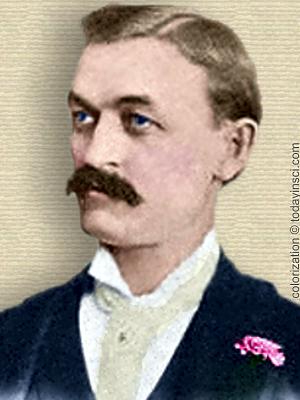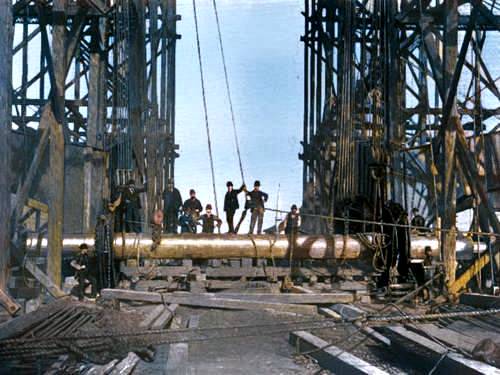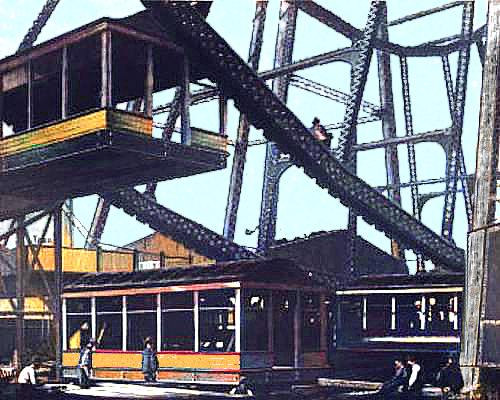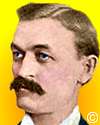 (source)
(source)
|
George Ferris
(14 Feb 1859 - 22 Nov 1896)
American engineer and inventor who invented the giant observation wheel for the World’s Columbian Exposition, Chicago, Illinois (1893).
|
Ferris Wheel.
by Luther V. Rice.
from Report of the Committee on Awards of the World’s Columbian Commission (1901)
[p.475] During the early days of the preexposition period the engineers and architects of all America who were interested in Exposition matters formed a Saturday afternoon club, at which engineering and architectural features of the Fair were discussed.
At one of these meetings Mr. D. H. Burnham asserted that the architects of America had covered themselves with glory and enduring fame by their artistic skill and original designs of mammoth buildings, while the civil engineers had contributed little or nothing either in the way of originating novel features or of showing the possibilities of modern engineering practice in America. Some distinctive feature was needed, something to take the relative position in the World’s Columbian Exposition that was filled by the Eiffel Tower at the Paris Exposition. Towers of various kinds had been proposed, but towers were not original; all that could be done in that line would be to out-Eiffel Eiffel; that is, build a larger tower than was built by him. But mere bigness was not what was wanted—something novel, original, daring, and unique must be designed and built if American engineers were to retain their prestige and standing.
Seated at the table, listening to Mr. Burnham’s remarks, was a tall, slight, young engineer, with a pale, resolute face. This was George W. G. Ferris, senior partner in the firm of G. W. G. Ferris & Co., bridge builders and inspecting engineers. Cut to the quick by the truth of these remarks, he registered a vow that he would design and build something which would be a credit to his profession. After casting several things over in his mind, the idea of a great observation wheel came to him like an inspiration. That night, in the company of a small party of friends, he rapidly sketched his plans in the rough.
The inspiration of the moment was the stroke of genius. The original sketch was so perfect that it was carried out in its entirety; not a single change was made. Returning to his home in Pittsburg, Mr. Ferris immediately set his draftsmen at work making detail drawings. Mr. W. F. Gronau was placed in immediate charge of this work. Strain sheets were made, and the stresses were computed for every possible load or strain to which the wheel could be subjected. This was no easy task, as Mr. Ferris’s plans were for a tension wheel, and the [p.476] stresses for such a structure had never before been computed. There was absolutely no data upon the subject, no precedent to follow, so the methods of calculating and designing had to be originated and thoroughly proven by mathematical demonstration.
In the spring of 1892 Mr. Ferris went to the ways and means committee of the World’s Columbian Exposition with his plans for a vertical revolving wheel 250 feet in diameter and capable of carrying 2,260 people at a load. His ideas were accounted as those of a visionary and an enthusiast. He became known as the man with wheels in his head. But he was deeply in earnest, and in June a concession was granted him, only to be revoked the next day. One member of the committee said that the wheel would be a “monstrosity,” and out of keeping with the dignity of the Exposition. Others thought it a waste of time to further consider a thing that would certainly be a failure. Even engineers doubted its practicability. Some claimed that it could not be built, others that it could not be operated even if it was built. In spite of all opposition, however, Mr. Ferris kept quietly at work organizing a company to build the wheel, and renewed his efforts to secure a concession. Capitalists were not very eager to invest in a scheme which was apparently so chimerical in its nature as this one, but this quiet and enthusiastic young engineer inspired confidence, and finally the stock was almost all taken.
Renewed and persistent efforts to secure the concession to build the wheel inside the grounds finally resulted in a concession being granted for this purpose, not in Jackson Park itself, but in Central avenue, Midway Plaisance. By the terms of this concession, which was granted December 16, 1892, the Ferris Wheel Company was to retain the first $300,000 received from the sale of tickets, after which one-half of the gross receipts were to be paid to the World’s Columbian Exposition. It was now midwinter and only four months until the opening of the Exposition. The mills, machine and bridge shops over the country were full to overflowing with orders. Most men would have hesitated even then because of the seeming physical impossibility of constructing such a massive piece of machinery in so short a time. But Mr. Ferris never hesitated an instant. His intimate knowledge of the mills and machine shops throughout the country, gained in his business as a bridge builder and inspector, was now of incalculable value to him and to his project. No one shop could begin to do all the work, therefore contracts were let to a dozen different firms, each being chosen because of some peculiar fitness for the work intrusted to it. The firm of G. W. G. Ferris & Co. was called upon for an army of trained inspectors, who rigidly examined all work in the different shops. Absolute precision was necessary, as few of the parts could be put together until they were upon the ground, and an error of the smallest fraction of an inch might be fatal.
[p.477] Meanwhile the foundation work, which Mr. Ferris had placed in charge of Luther V. Rice, was proceeding slowly and under many difficulties. The winter was the most severe that Chicago had experienced for many years; the frost at the wheel site was 3 feet deep; the quicksand was 20 feet in depth and saturated with water. All of this had to be excavated, and a solid concrete monolith, interspersed with steel beams resting upon piles driven through blue clay to hardpan, 32 feet from the surface, was built to get a secure foundation for the towers. Pumps were kept running night and day to keep out the water, and live steam had to be used to thaw the sand and broken stone. On the 20th day of March, 1893, the first tower post was put in place. Soon after came the problem of raising the axle. This axle, which bore the entire weight of the wheel, cars, and people, was forged by the Bethlehem Iron Company, was 45 feet long, 32 inches in diameter, and weighed 45 tons. Upon the axle were two immense spiders or hubs, each weighing 12½ tons. This immense weight of 70 tons was lifted 140 feet and placed in beams upon the towers in two hours’ time. The spokes, which were adjustable iron rods 2-9/16 inches in diameter and 80 feet long, were then suspended from the hubs. The wheel had an outer and an inner rim or felloe, the latter being 45 feet inside of the former. The wheel was in reality a double one, or two wheels attached to one axle with a spacing of 28½ feet between them, thoroughly tied together with struts and diagonal rods, and the rim was composed of 36 sections, built up in the same manner as bridge chords. Between the two rims and attached to the spoke rods was a stiff spoke or post. Starting from the bottom and working in both directions, these sections were attached one by one and securely bolted together. Above the axle the rims of course gradually approached one another as section after section was put in place, until finally the last section was hoisted 264 feet and the two parts of the rim were joined, which made the circle complete.
Meanwhile the power plant has been put in place. The toilers were on Lexington avenue between Sixtieth and Sixty-first streets, over 700 feet away and outside of the grounds. Steam was conveyed to the engines by an underground 10-inch wrought-iron pipe, the exhaust steam being carried back to the boilers by a second underground pipe. The mighty 1,000-horsepower engines were in place and power was transmitted to the wheel by a triple set of gear wheels which run a sprocket chain, the pins of which fitted in the serrated teeth of a cast-iron segment securely bolted to the outer chord or rim.
As soon as the last connection was made preparations were immediately made to turn the great wheel. Mr. Ferris was in the East on pressing business when the final connections were made, but had given parting instructions to turn the wheel or tear it off the towers. It was a critical moment. Steam was admitted into the cylinders and [p.478] the engines started. Trusted men were at every point to watch the action of every piece of mechanism. The wheel revolved steadily and surely and the doubting Thomases were silenced.
When it was seen that the wheel was moving, the foreigners in this street of many nations came running from all sides, shouting vociferously and gesticulating wildly. The wheel had been an enigma to them; now they hastened with their weird and uncanny musical instruments to celebrate this glorious triumph of American industry and skill.
Between the outer rims of the two wheels the cars for carrying the people were swung on pins or pivots 6½ inches in diameter. These cars were 26 feet long, 13 feet wide, and about 9 feet high, with plate-glass windows and a door at each end. Thirty-eight fancy twisted-steel chairs were in each one. There were 36 cars in all, 1 being hung at each panel point at the extreme end of the spokes.
On June 11 a trial trip was made with 6 cars. The wheel had not been adjusted and the superintendent wished to make one trip around to see how it would act. Mrs. Ferris, who had cheered her husband in the darkest hours of the enterprise and had given many words of encouragement to the men in charge of the construction work, was present, and bravely determined to make the first trip. She did not falter one moment, nor did she show one sign of fear while making that perilous trip. Upon her return to earth Mr. Ferris was wired the particulars and immediately telegraphed back, “God bless you, my dear.”
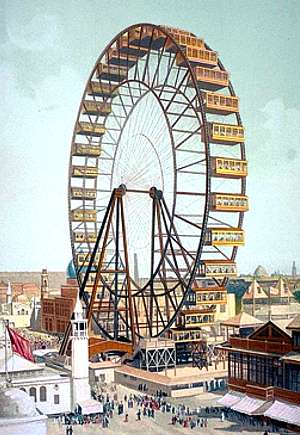
From Hubert Howe Bancroft, The Book of the Fair (1895). (source)
The opening day was set for the 21st of June. Speeches were made by Capt. Robert W. Hunt, president, and Judge William A. Vincent, secretary, on behalf of the company, while Maj. Moses P. Handy spoke on behalf of the World’s Columbian Exposition. Other speakers were Gen. Nelson A. Miles and, last, Mr. G. W. G. Ferris. In a happily framed speech he called attention to the fact that he had “gotten the wheels out of his head and made them a living reality.” The final success of his scheme he feelingly attributed to his wife, Margaret A. Ferris. In closing he dedicated his work to the engineers of America. Mrs. Ferris then presented him with a golden whistle, which he blew as a signal for starting the wheel. The Iowa State band struck up “America” and the great wheel slowly and majestically revolved, while the air was rent with cheers by the assembled thousands.
Although the wheel was perfectly safe in itself, yet accidents might occur which would bring it into disrepute. To guard against this every precaution possible was taken by the management. Doors were locked and heavy iron screens covered the windows of the cars, making it impossible for a person to get out while the wheel was in motion. There were six platforms on each side at different elevations, so that six cars could be loaded and unloaded at once, the people coming in at [p.479] one end of the car and passing out at the other. Upon each platform was stationed a uniformed guard, whose business it was to open platform gates and car doors, allowing the people to pass into the car. After the car was filled each guard closed the door of his car and signaled the engineer by an electric bell and annunciator that his platform was clear. Not until he had the signal from each platform did the engineer open the throttle. To insure his control of the wheel it was equipped with double Westinghouse air brakes, which effectually controlled its movements under all conditions. Uniformed conductors in each car answered the questions of the wheel patrons and, when necessary, soothed their fears. Not one of the one and three-quarter million passengers carried was injured in any way. The story of the pug dog jumping out of one of the car windows was concocted by some space writer who was short on news and long on invention. Equally false were the reports that the wheel stopped for some hours with a number of people in the top cars. The wheel ran upon the schedule time of twenty minutes for the double round trip from the time it started until the close of the Fair. There were no delays or halts of any kind. The engine always had up steam and there was always a clear track and no breakdowns.
This record of almost five months’ constant running for such an intricate mass of mechanism without a single hitch is simply marvelous. It is an added triumph to American engineering ability and skill.
Arrangements were made at an early date for the installation of an electric-light plant in the boiler house. The current was carried by underground wires to the wheel. The towers, fence, and wheel were studded with 3,000 incandescent lights. But though the night view from the wheel was equal to a glimpse of fairy land, the night trip never became popular.
The capacity of the wheel was never taxed; even on Chicago day when there were 34,433 paid admissions. During the months of June, July, and August few people were carried before 11 o’clock, and the heaviest hour’s business was between 5 and 6 in the afternoon. In September and October, however, as many people were carried between 9 and 10 a. in. as between the heavy afternoon hour. On the 19th of October there were 1,784 people on the wheel during one trip. The largest number of people carried in any one hour was about 4,000.
The paid admissions to the wheel on week days was about 9 per cent and on Sunday about 12 per cent of the paid admissions to the Exposition. If each visitor made an average of eight trips to the Fair, the percentage of separate people in attendance carried by the wheel was about 70. The patrons were from all stations of life. The rich and poor, high and low, senators, governors, farmers, merchants, [p.480] mechanics, and laboring men all seemed equally anxious to take a ride upon this novel wheel. Letters were received from several couples who wished to be married in the highest car. Two of them went so far as to have their invitations printed inviting their friends to the Ferris wheel to see them married in one of its cars. The management was not seeking notoriety, however, and they were forced to be content with a wedding ceremony performed in the office of the superintendent. The view from the wheel on a clear day was magnificent, but as the patronage upon a dark, smoky day was nearly as large as upon a perfectly clear one, the conclusion is almost forced upon one that the people were much more interested in the daring design and unique structure planned and built by Mr. Ferris than they were in landscape views or effects, no matter how beautiful they may have been.
- 14 Feb - short biography, births, deaths and events on date of Ferris's birth.
- George Ferris: Lighting of the Ferris Wheel - from Electricity at the Columbian Exposition (1894).
- 21 Jun - short biography, births, deaths and events on date of Opening the Ferris Wheel.
- Circles in the Sky the Life and Times of George Ferris, by Richard Weingardt. - book suggestion.
- Booklist for Ferris Wheel.
